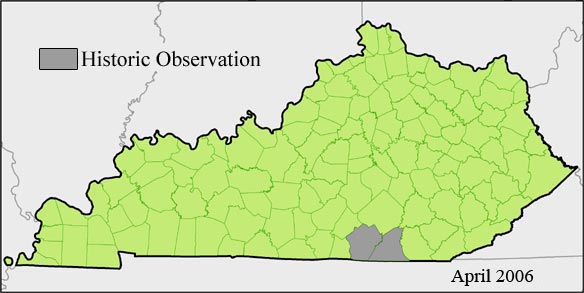P�h�o�t�o� �b�y� �K�S�N�P�C� �S�t�a�f�f�
|
Habitat:
Edges (usually) of moist to dry pinelands, oak woods, or clearings (Fernald 1970); moist sandy soil (Gleason & Cronquist 1991).
|
Species Description:
An erect finely hairy perennial with simple alterante leaves that are progressively smaller up the stem. The plants are 3-6 dm tall. Flowers are solitary, two-lipped, yellow and purplish or reddish in the upper leaf axils.
|
Phenology:
Flowering Period: Early May to late June.
Fruiting Period: Early August to late August.
|
Additional Information at NatureServe
|
Diagnostic Characteristics:
This species is distinguished by a 3-6 dm unbranched stem with alternate leaves, largest at the base, gradually diminishing upwards; two-lipped flowers, 3-3.5 cm long, yellow suffused with purple near the open end; hairy stems and leaves; and a posterior sepal and two bractlets subtending each flower. (Medley 1993).
|
Management:
Woody plant invasion may need to be controlled using periodic prescribed fire, mowing or other means to maintain the open character of the habitat for this species. Hand removal of trees in the vicinity of the species is necessary. Soil disturbance resulting from activities such as ATV trails, timber removal or any activity that results in increased erosion and weed invasion will be detrimental. Exotic pest plants are a threat to this species and should be removed.
|
Global Range:
HISTORIC RANGE: A state-by-state breakdown of historic and extirpated records for Schwalbea americana follows: Massachusetts- ten sites from Barnstable, Bristol, Dukes, Franklin, Nantucket, Norfolk, Plymouth, and Worcester counties; Nantucket Island (last verified 1963) (Rawinski and Cassin 1986, Sorrie 1987, 1988); Connecticut- one site in Middlesex County (TNC 1985); New York- one site in Albany county (1865 near Albany in Pine Bush) (Zaremba 1988); New Jersey- sixteen sites in Atlantic, Burlington, Camden, Cape May, Cumberland, and Ocean counties (NJNHP 1985, Snyder 1988); Delaware- one site in New Castle county (last observed 1875, now Chesapeake and Delaware Canal?) (Vickers 1988); Maryland- one site in Worcester county (1893 near Ocean City) (TNC 1985); also a report from Anne Arundel county, Maryland; Virginia- one site on a line between Sussex and Greensville counties (last collected 1938) (Fernald 1939, Terwilliger 1991); North Carolina- six sites in (year last seen follows in parentheses) Bladen (1957), Hoke (1959), Moore (1901), Pender (1951, 1953), and Scotland (1949) counties (NCNHP 1993); South Carolina- eight sites in Berkeley, Beaufort, Charleston, Florence, Horry, Jasper, Sumter, and Williamsburg counties (Rayner 1986); Georgia- four sites in Baldwin, Early, Miller, and Pike counties (Jones and Coile 1988, Patrick 1993); Florida- seven sites confirmed extirpated in Brevard, Duval, Highlands, Leon Levy, Putnam, and Volusia counties (Kral 1983); Alabama- three sites in Baldwin, Geneva, and Mobile counties (Kral 1983); Mississippi- two sites extirpated in Covington and Jackson counties (Rawinski and Cassin 1986, Peters 1992); Louisiana- one site in Rapides Parish (Vincent 1982) [Note: the Rapides Parish records are based on specimens collected by Hale around 1850 which have no location data on the pre-printed labels but which indicate "Alexandria, Rapides Parish," Hale's residence; thus, one cannot consider the records as validly attributable to Louisiana (Larke 1993)]; reported from Calcasieu Parish (MacRoberts 1989); Texas- apparently a specimen record from east Texas (Correll and Johnston 1970); Tennessee- two sites in Coffee (last observed 1879) and Fentress (1842) counties (Somers 1988); Kentucky- two sites in McCreary County on Tennessee border (Braun 1936, Harker et al. 1981).
CURRENT RANGE: A summary of the 51 extant occurrences by state follows: In New Jersey, a single remaining population in Lebanon State Forest in Burlington county, the only remaining population north of North Carolina, occurs at a sandy, mowed roadside edge of a pitch pine-dominated, lowland Pine Barrens forest (NJNHP 1985, Snyder 1988, Peters 1992). Unfortunately, it appears that poorly timed mowing (during flowering period) has caused a precipitous decline in the number of plants (only three or four) at this site (Snyder 1993). A second occurrence known since 1919, was extirpated in 1988 by the construction of a street for new housing (Snyder 1988). This occurrence occupied an old building site on flat, sandy soil, regrown with 2-3" dbh trees of sassafras and sycamore. Other associated species included Rhus copallinum, Solidago odora, Danthonia sericea, Baptisia tinctoria, Aster dumosus, Senecio tomentosus, Chrysopsis mariana, Solidago nemoralis, Euthamia tenuifolia, and E. graminifolia (Stasz 1985a). There are currently 18 extant occurrences of chaffseed in North Carolina. Two are on private land in Moore County; the remaining sixteen occurrences are found on Fort Bragg in Hoke (14) and Cumberland (2) counties (a total of 63 sites) (NCNHP 1993). The larger occurrences are located on or near live-ammunition impact areas. These sites burn at least in part annually from fires started by explosions and night flares, indicating that the species is "strongly" fire-dependent (Weakley 1988). South Carolina has twenty-six extant occurrences in Berkeley, Charleston, Florence, Horry, Jasper, Lee, Sumter, and Williamsburg counties; the largest colony totaling 4,000 plants (Rayner 1986). Plants are found in communities of open, moist pine/wiregrass flatwoods with associates including Scleria spp., Helianthus radula, and Pterocaulon pycnostachyum (White 1988). One occurrence in a high-fire-frequency ecotone between a pine savanna and flatwoods includes rare associates Parnassia caroliniana and Pteroglossaspis ecristata (Rayner 1986). Another occurrence in Sumter County is adjacent to a wet pond cypress savanna in a Carolina bay. Several new occurrences were found in Williamsburg county in 1993 (Porcher 1993). Georgia has five extant occurrences, four at Ichauway Plantation, Baker county, and one in Dougherty county (Peters 1992, Kirkman 1993, Patrick 1993). The only Florida population is located on the panhandle, in Gadsden county, in "recently burned scrubs in loamy sand" (White 1988, Amoroso 1993). In Mississippi, a report from Noxubee National Wildlife Refuge, Noxubee county (Peters 1992) proved to be a misidentification of Parentucellia viscosa, an introduction from the Mediterranean region (TNC 1991-93). Chaffseed is believed extirpated from Alabama, Connecticut, Delaware, Kentucky, Maryland, Massachusetts, Mississippi, New York, Tennessee, Texas, and Virginia (Peters 1992).
|
Known Kentucky Occurrences:

|
|